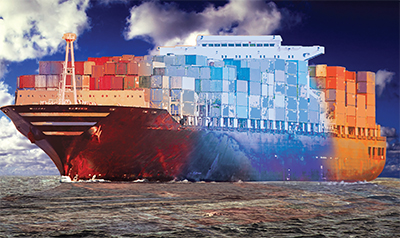Carrier Consolidation Keeps Shippers Guessing
The flurry of buyouts and consolidation in the ocean cargo arena has shippers scrambling to book space and reconfigure supply chains this season. Meanwhile, logistics managers must make sense of new rumors that yet another major player may be for sale.
When South Korea’s Hanjin declared bankruptcy late last summer and began abandoning vessels at ports worldwide, it appeared that shippers’ worst nightmare might have finally been realized. But the hope then was that order would surface out of chaos in typical Homeric fashion, and all would be right with the world by now.
Dream on, say industry analysts, who only predict continued carrier disruption in the future.
As of this month, only 17 large-scale international carriers remain, down from 20 just a year ago. The reduction results from the acquisition of APL by CMA CGM and from the integration of CSCL within COSCO. This number will shrink further in 2017 with the pending conclusion of the Hapag-Lloyd and UASC merger, the acquisition of Hamburg Su¨d by Maersk and the merger of K Line, MOL and NYK’s liner shipping businesses. 
The three Japanese carriers will form their new joint venture—to be known as J-3—this July, and begin operating a joint service April 1, 2018.
“The overall capacity operated by the 17 main carriers shrank by 1.3% over the last 12 months, after taking into account the removal of Hanjin’s tonnage,” observes Tan Hua Joo, an analyst with the Paris-based consultancy Alphaliner. “Collectively, these carriers control 81.2% of the global liner capacity as of January 1, 2017, compared to 83.7% controlled by the 20 main carriers a year ago.”
Apart from Hanjin Shipping, five other carriers logged capacity reductions, with Zim recording the largest loss as its operated capacity shrank by 14.8%. MOL and K Line also recorded significant capacity reductions of 10.6% and 7.7% respectively ahead of the planned merger with NYK to form the J-3 partnership.
“Although CMA CGM Group’s operated capacity grew by 17.3% thanks to the APL purchase, the aggregated capacity of both carriers fell by 9.3%, due mainly to the outsourcing of a substantial part of CMA CGM’s transhipment activities,” says Joo. “Hamburg Süd was also forced to rationalize its operated capacity due to the very weak trading conditions on its core South America routes. The carrier’s operated fleet shrunk by 6.6% last year.”
More trans-Pacific shakeups
If this wasn’t confusing enough, a new rumor surfaced last month that yet another buyout was in the cards in the Asia Pacific trade lanes. According to reports published in South Korea news agencies, Samra Midas Group (SM Group) will create a separate company called SM Lines that will operate what’s left of Hanjin’s liner business between the Far East and the United States.
Meanwhile, existing alliances are putting together their long-term plans for the trans-Pacific this year. Hyundai Merchant Marine (HMM) is forming a consortium with smaller South Korean carriers—Heung-A Shipping and Sinokor Merchant Marine—for moving cargo within Asia.
The “HMM + K2” consortium begins operations in March that will cover Japan, China and South East/West Asia trades, and will be automatically renewed for successive two year terms. According to spokesmen, HMM said that the agreement will allow it to acquire competitiveness against large carriers.
HMM has 60 vessels with a combined capacity of 409,619 twenty-foot equivalent units (TEUs) deployed on services. Currently, Heung-A is deploying 34,760 TEUs with 25 vessels, while Sinokor is deploying 30,305 TEUs with 17 vessels.
According to Larry Gross, a partner at FTR Transportation, the fallout from all of these new alignments—in the trans-Pacific and elsewhere—may mean more focused customer service. “Shippers have treated container shipping as a pure commodity play, but now they realize not all carriers are built the same,” he says. “I think we may see a bit of a flight to quality as BCOs [beneficial cargo owners] seek more stable partnerships.”
U.S. Federal Maritime Commissioner William Doyle says that this new generation of alliances has received worldwide regulatory approval, but cautions shippers to carefully evaluate contracts before reconfiguring their supply chains.
“Shippers are concerned with ocean carrier alliances in the wake of Hanjin’s bankruptcy,” notes Doyle. “They should make every effort to secure the appropriate safeguards from these new partnerships.”
Doyle is urging logistics managers to work with carriers on ways to obtain insurance contracts, bonding, or other financial instruments as soon as possible. “I would suggest shippers get started now,” he says.
This urgency demonstrated by Doyle is now further fueled by rumors that Hong Kong-based container carrier Orient Overseas Container Line (OOCL) might be an acquisition target this winter.
According to Drewry Financial Research Services, the investment research arm of London-based shipping research and consulting firm Drewry, there has been some speculation that Orient Overseas International Limited (OOIL) may have told shareholders to brace for just such an announcement. OOIL denies that there is any truth to this, however.
Forecasting for 2020
Martin Dixon, director of research products for Drewry Maritime Trade Advisors, says that 2017 and 2018 will be challenging on the supply front despite the huge scrapping effort undertaken by carriers.
“By 2019, the industry has a chance to emerge from its super-cycle trough as much stronger order books and supply pressure stops,” says Dixon. “But while intense consolidation is the reaction to the market ills, and is a positive, it’s not the savior alone.”
Dixon concludes that freight rates rebounded strongly in the second half of 2016 and shippers should prepare for 20% to 40% higher contracts in 2017.
Meanwhile, a new report issued by The Boston Consulting Group (BSG) maintains that container lines must continue to adopt future strategies for enhancing their performance in a global shipping environment that’s characterized by declining demand.
The BSG report, “Sailing in Strong Winds: The New Normal in Global Trade and Container Shipping,” was released last November, just as some stability to the industry was being introduced.
“The report in some cases, overstates the obvious,” says Ulrik Sanders, a BSG senior partner and a co-author of the report. “Demand for containers picked up during 2015, but by the end of 2016, average global growth in the container-shipping trade was a disappointing 1.9%.”
Still, in a bid to boost scale and reduce slot costs, liners continued to invest in new and larger vessels. According to the report, this worsened the overcapacity that was already afflicting the market and pulled freight rates down to a new low. “In 2015, for the first time in history, growth in container demand lagged behind global gross domestic product,” adds Sanders.
To identify potential “culprits” behind the disappointing news for 2016, the authors analyzed the performance—including inbound and outbound volumes—of six major trade routes that collectively represent more than 80% of the total world container trade. According to their findings, performance varied depending on key drivers of demand in the various markets, such as industrial and consumer demand, as well as structural changes in economies such as China.
In addition to analyzing container demand volumes in 2015 for key trades, the authors assessed the main drivers of demand to develop several scenarios—stable, cautious and optimistic—for how global container shipping might shape up over the remainder of the decade.
The authors also closely examined possible scenarios for container demand and container supply-and-demand balance over a six-year period. For container demand, they expect global container traffic to grow from 2.2% to 3.8% annually from 2015 through 2020, depending on the growth performance in each of the six major trades.
-wide.jpg)
For container supply-and-demand balance, they anticipate a supply-demand gap ranging from 8.2% to 13.8% in 2020—the gap was 7% in 2015. The authors estimate that by the end of 2020, oversupply in vessel capacity will stand at 2 million to 3.3 million TEUs—that equates to 90 to 150 Triple E class “Mega” vessels.
Bob Barranco, executive vice president of Barr Freight System, a Chicago-based freight forwarder, offers a slightly less theoretical summary to the situation in which the market now finds itself. “It seems almost incomprehensible that such large corporate entities with such wide global perspective could have permitted themselves to degenerate into a state of financial disarray…as many of them have,” he adds.

Article Topics
Ocean Freight News & Resources
Descartes March Global Shipping Report highlights ongoing steady volume momentum U.S.-bound import growth track remains promising, notes Port Tracker report Nimble shippers coping with Baltimore port closing by shifting plans Q&A: Port of Oakland Maritime Director Bryan Brandes Signs of progress are being made towards moving cargo in and out of Baltimore Industry experts weigh in on Baltimore bridge collapse and subsequent supply chain implications Expensive, lengthy delays expected before Port of Baltimore can re-open to vessels following Key Bridge collapse More Ocean FreightLatest in Logistics
Descartes announces acquisition of Dublin, Ireland-based Aerospace Software Developments Amid ongoing unexpected events, supply chains continue to readjust and adapt Shipment and expenditure decreases trend down, notes Cass Freight Index March trucking tonnage trends down, reports ATA FTR Shippers Conditions Index enters negative territory DAT March Truckload Volume Index sees modest March gains National diesel average, for week of April 22, is down for the second straight week More LogisticsAbout the Author
Subscribe to Logistics Management Magazine

Find out what the world's most innovative companies are doing to improve productivity in their plants and distribution centers.
Start your FREE subscription today.
April 2023 Logistics Management

Latest Resources
















